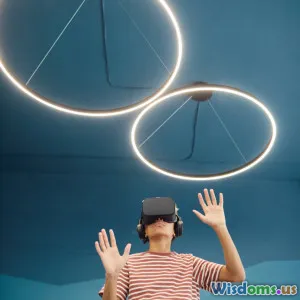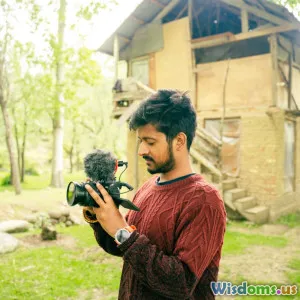
The Future of Immersive Storytelling
8 min read Explore how immersive storytelling is transforming photography and filmmaking with emerging technologies and creative innovations. (0 Reviews)
The Future of Immersive Storytelling in Photography & Filmmaking
The art of storytelling has always evolved alongside technology, but today, we stand at a crossroads where traditional narratives are dramatically reshaped by immersive tools and techniques. As photography and filmmaking embrace virtual reality (VR), augmented reality (AR), artificial intelligence (AI), and interactive formats, the way audiences engage with stories is transforming beyond passive consumption to active participation.
In this article, we'll journey through the defining technologies and creative strategies driving the future of immersive storytelling, exploring tangible examples and industry insights to paint a clear picture of what's to come.
What is Immersive Storytelling?
Immersive storytelling refers to techniques and media that engage audiences deeply by blending them into the narrative's world, expanding beyond traditional two-dimensional screens. Through sensory engagement—visual, auditory, and sometimes haptic—immersive stories create emotionally resonant and interactive experiences.
Unlike classic films or photo essays, which position viewers as observers, immersive storytelling invites viewers to be explorers, decision-makers, or even co-creators.
Technological Foundations Transforming Storytelling
Virtual Reality (VR): Stepping Inside the Frame
VR technology lets audiences literally step into a story. Users wear headsets to experience fully 360-degree, three-dimensional worlds. For instance, acclaimed VR projects like “Dear Angelica” by Oculus use hand-painted animation within a 3D space to convey deeply personal experiences.
According to a report by PwC, the VR and AR market in media and entertainment is projected to reach $122 billion by 2022, signaling widespread adoption. In filmmaking, VR enables directors to craft narratives where viewers control viewpoint and pacing, shifting traditional authorship paradigms.
Augmented Reality (AR): Layering Stories Over Reality
AR overlays digital content onto real-world environments, enhancing photography and filmmaking. Snapchat and Instagram face filters stand as popular everyday AR examples, but brands and artists use AR for immersive campaigns.
Take the “IKEA Place” app, for instance: it allows users to place virtual furniture in their physical rooms, turning ambient environments into storytelling canvases. Such integrations cultivate richer context and personalized narratives.
Artificial Intelligence (AI): Dynamic and Personalized Narratives
AI’s role is multifaceted. Natural language processing and computer vision enable AI to curate story elements dynamically based on viewer reactions or input. Spielberg’s upcoming project “The Electric State” reportedly explores AI-generated immersive set extension.
Startups like Artie focus on AI-driven interactive characters that adapt their dialogue and behavior, enhancing empathy and responsiveness within story worlds.
5G and Real-Time Interactivity
The roll-out of 5G technology will significantly reduce latency, enabling more seamless, real-time interactive experiences at scale. Highly responsive VR film experiences or collaborative AR storytelling become possible as streaming quality improves globally.
Creative Innovations Driving Immersive Storytelling
Non-Linear and Branching Narratives
Immersive storytelling often abandons rigid timelines. Shows like Netflix’s “Black Mirror: Bandersnatch” pioneered nonlinear interactive narratives where viewer decisions influence outcomes.
Filmmakers are now designing stories as interactive journeys with multiple endings or shifting perspectives, encouraging viewers to replay and discover new depths.
Multi-Sensory Engagement
Future storytelling combines sound design, spatial audio, and haptic feedback. For example, VR experiences utilize 3D audio to simulate real environments, making scenes lifelike.
Interactive gloves and suits, such as those developed by AxonVR, provide touch sensations, amplifying immersion beyond sight and sound.
Collaborative Storytelling Platforms
Crowdsourced and multiplayer storytelling is rising. Platforms like VRChat allow users to co-create story scenarios, blending filmmaking with social media dynamics.
Projects like “The Infinite Hotel” encourage real-time collaboration to build story environments, democratizing narrative control and creativity.
Challenges and Ethical Considerations
Immersive storytelling faces hurdles such as high production costs, technical accessibility, and potential sensory overload. Creators must balance immersion with user comfort to avoid issues like motion sickness.
Ethically, immersive narratives carry responsibility. When stories engage users emotionally and interactively, creators influence perceptions powerfully. Transparent design and cultural sensitivity become paramount to avoid manipulation or desensitization.
Real-World Impact and Case Studies
National Geographic’s VR Expeditions
National Geographic has pioneered VR documentaries transporting viewers to remote locales like the Galápagos Islands, fostering empathy for environmental issues by first-hand virtual exploration.
Documentary Filmmaking with 360 Video
The “Clouds Over Sidra” VR documentary depicting a Syrian refugee camp humanizes statistics by creating embodied experiences, influencing policy discussions and fundraising.
AI in Photography: Computational Creativity
AI-assisted photography tools (e.g., Adobe Sensei) help photographers automate complex edits but push creative boundaries by remixing styles or suggesting compositions, merging machine efficiency with artistic intuition.
What the Future Holds: Predictions and Opportunities
-
Hybrid Storytelling Forms: The merging of live-action, animation, VR, and AR will become seamless, creating hybrid media pushing audience engagement deeper.
-
Personalized Immersion Engines: AI will tailor story worlds in real-time based on biometric data or viewer preferences, creating uniquely personal experiences.
-
Accessibility Innovations: As hardware becomes more affordable, immersive storytelling will democratize, empowering independent creators globally.
-
Educational and Therapeutic Applications: Beyond entertainment, immersive stories will expand in education and mental health, delivering impactful empathetic learning and healing.
Conclusion
Immersive storytelling is not a distant dream but a rapidly expanding reality redefining photography and filmmaking. By merging ground-breaking technologies with visionary creativity, stories transcend screens to become living environments where audiences engage more meaningfully.
As creators harness VR, AR, AI, and 5G, with sensitivity to ethical implications, the possibilities are vast—from fostering global empathy to enriching entertainment. For photographers and filmmakers, mastering immersive techniques promises not just to tell better stories but to transform how people experience the world around them.
The future invites storytellers to step beyond frames and scripts into realms where imagination and technology unite to craft vivid, interactive human experiences. Your journey into immersive storytelling starts now.
Rate the Post
User Reviews
Popular Posts





















